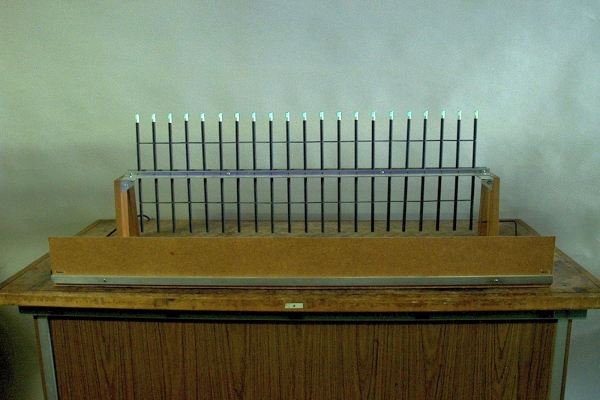
By giving a quick back-and-forth motion to the rod at one end of this machine, you can set each of the other rods, in sequence, in similar motion, generating a (longitudinal) pulse that travels along the length of the machine. By moving the rod in a slow, periodic rhythm, you can generate standing waves. With the clamp, visible at right in the photograph near the leg of the apparatus, you can fix the rod at one end of the machine, to show the difference between reflection from an open end and that from a closed end, and the set of standing waves, different from those for the open end, that you get with the closed end. The strip light, which has an ultraviolet fluorescent tube (“black light”), whose output excites the fluorescent dots on the top ends of the rods, causing them to glow. This makes it easier to see the motion of the pulses or waves that you send along the machine.
The machine in the photograph above consists of 21 rods, each 35.7 cm long and having a mass of approximately 195 g, mounted on a pivot just above its center of mass. The rods are spaced 5 cm apart, and joined by two long springs, one that passes through all the rods in the middle of their bottom half, and one that passes through them on their top half. The tops of the rods are painted white, each with a yellow spot that fluoresces under UV light. As described above, you can manipulate the rod at either end, to send pulses down the machine, either individually, or periodically to generate standing waves. In this particular machine, the motion of the rods is in the same direction as that in which the wave propagates. The wave is thus a longitudinal wave. Because the rod motion is in the same direction as the wave propagation, it is somewhat difficult to see the difference between the reflection of a single pulse at an open end, and one reflected at a closed end, though with the closed end, if you send a positive (inward) pulse, the first few rods in from the end kick sharply backwards, which they do not do when the end is open. (This phenomenon is much easier to see with demonstration 40.60 -- Transverse wave machine with free or fixed end, in which the rod motion is perpendicular to the direction of the wave propagation.) It is, however, much easier to see the nodes and antinodes of a standing wave, especially if there is at least one node within the span of the machine (i.e., not just at the closed end(s)).
The wave motion in this machine is analogous to that in a compression wave, which is what a sound wave is in air. Just as with the ends of a medium in which a transverse wave propagates, at an open end, a longitudinal wave is reflected in phase with itself, and at a closed end, it is reflected out of phase. When you drive the machine by moving the rod at one end, you constrain the motion of that rod, and that end of the machine acts as a closed end. The two possibilities, then, are to drive the machine with one closed end and one open end, or to clamp the opposite end, and drive it with two closed ends. With both ends closed, there is a node at each end, and the length of the machine corresponds to integer multiples of half wavelengths. With one end open, there is a node at the end where your hand is, and an antinode at the open end, and the length of the machine corresponds to odd integer multiples of quarter wavelengths. For a sound wave, the first case is analogous, for example, to the Rubens flame tube (demonstration 44.39), in which both ends are closed (all half wavelengths), and the second case is analagous, for example, to an organ pipe with one end open and the other closed (odd quarter wavelengths, as in demonstration 44.36 -- Speaker over water-filled tube).